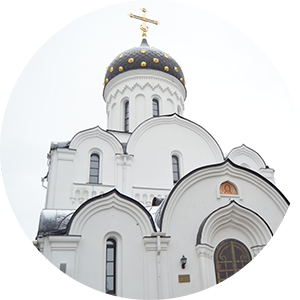St. Sava of Storozhevsk and Zvenigorodsk in his
early youth left the world, accepting tonsure under St. Sergius of
Radonezh, for whom he was one of the first disciples and co-ascetics.
 St. Sava loved the quiet life, he shunned
conversing with people and he lived in constant toil, in lamentation over the
poverty of his soul and remembrance of the judgement of God. The saint was
a model of simplicity and humility, and he attained to such a depth of
spiritual wisdom, that "in St. Sergius Monastery he was a
spiritual confessor to all the brethren, a venerable starets-elder and
exceedingly learned". When GreatPrince Dimitrii Donskoy, in gratitude for
the victory over Mamai, built the monastery of the Uspenie-Dormition of the
Mother of God at the River Dubenka, Sava became its hegumen, with the blessing
of St. Sergius. Preserving the simple manner of his ascetic lifestyle, he
ate food only of plants, wore coarse clothing and slept on the ground.
St. Sava loved the quiet life, he shunned
conversing with people and he lived in constant toil, in lamentation over the
poverty of his soul and remembrance of the judgement of God. The saint was
a model of simplicity and humility, and he attained to such a depth of
spiritual wisdom, that "in St. Sergius Monastery he was a
spiritual confessor to all the brethren, a venerable starets-elder and
exceedingly learned". When GreatPrince Dimitrii Donskoy, in gratitude for
the victory over Mamai, built the monastery of the Uspenie-Dormition of the
Mother of God at the River Dubenka, Sava became its hegumen, with the blessing
of St. Sergius. Preserving the simple manner of his ascetic lifestyle, he
ate food only of plants, wore coarse clothing and slept on the ground.
In 1392 the brethren of the Sergiev Lavra, with the
departure of its hegumen Nikon into the wilderness, besought St. Sava to
accept being hegumen at the monastery. Here he "did well shepherd the
flock entrusted him, such as he could and such as the prayers of his spiritual
father Blessed Sergius did aid him". Tradition imputes to his time as
hegumen the finding of a spring of water beyond the Lavra walls.
A godson of St. Sergius, prince Yurii Dimitrievich
Zvenigorodsky, regarded St. Sava with great love and esteem. He chose the
saint as his spiritual father and besought him to come and bestow blessing
upon all his household. The saint had hoped to return to his monastery, but the
prince prevailed upon him to remain and set in place a new monastery, "in
his fatherland, near Zvenigorod, where the place was called Storozh".
Striving after the solitary and silent life, St. Sava accepted the offer
of the Zvenigorod prince Yurii Dimitrievich, and with tears before an icon of
the Mother of God he besought Her protection for the wilderness place. On the
Storozhevsk heights, where formerly was encamped a sentinel, guarding Moscow
from enemies, he set up a small wooden church of the Nativity of the MostHoly
Mother of God, and not far off from it made a small cell for himself. And here
in the year 1399 the saint established a monastery, fondly accepting all that
were come for the life of solitude. St. Sava toiled much at the building up of
his monastery. He himself dug out a well below the hill, from which on his
shoulders he carried his own water; he encircled the monastery with a wooden
palisade, and above it in an hollow he dug out for himself a cell for a life of
solitude.
In 1399 the St. Sava blessed his spiritual son,
prince Yurii, to go off on a military campaign, and he predicted victory over
the enemy. Through the prayers of the holy elder, the forces of the prince were
granted a speedy victory. Through the efforts of the saint, a stone church
of the Nativity of the MostHoly Mother of God was also built.
St. Sava died at an advanced age on December 3, 1406.
Veneration of St. Sava by the local people began
immediately at his death. The miraculous curative power, issuing from the grave
of the saint, and his numerous appearances, convinced everyone that Hegumen
Sava "is in truth an unsetting star-radiance of the Divine light, by the
shining forth of his miracles illumining all". In a letter of 1539 St. Sava is called a wonderworker. Tsar Alexei Mikhailovich had particular
esteem for him, repeatedly going on foot to venerate at the monastery of St. Sava. Tradition has preserved for us a remarkable account, of how the
saint had saved him from a ferocious bear.
The Life of St. Sava, compiled in the XVI
Century, relates how at the end of the XV Century (years 1480-1490), the saint
appeared to the Savinsk monastery hegumen Dionysii and said to him:
"Dionysii! Wake up and write my face upon an icon". To the question
of Dionysii, as to whom he was, came the reply: "I am Sava, the founder
of this place". An old starets-elder of the monastery named Habbakuk,
having in his youth seen St. Sava, described the outward appearance of
the saint. And it was precisely such as the saint appeared to Abbot Dionysii, who fulfilled the command and wrote the icon of the saint.
The feast day of St. Sava of Zvenigorod was established in the
year 1547. On January 19, 1652 the incorrupt relics of
the saint were uncovered.
Source: http://www.holytrinityorthodox.com/calendar/los/January/19-04.htm
 |
| Help support the ministry of St. Elisabeth Convent |


















CONVERSATION